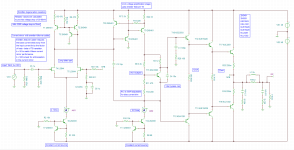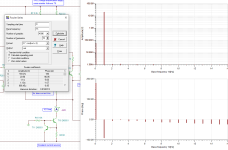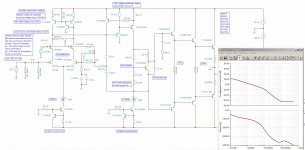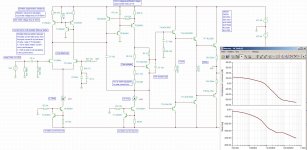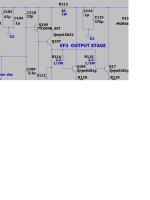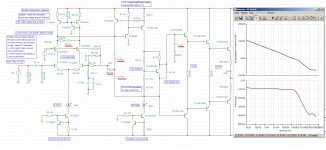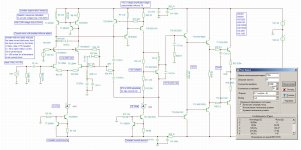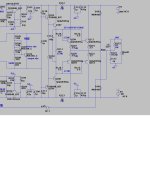Hi all,
Schematics is one-to-one from the application note for LS844 JFETS (those are dual 2SK170).
https://www.digikey.com/en/pdf/l/linear-integrated-systems/ls844-application-note
I was wondering what kind of distortion figures this amplifier produces so I simulated this in TINA TI.
Few models were missing so I had to search for those.
MJE15032 and MJE15033 transistors are not available and were substituted.
Attached are all sim files.
Schematics is one-to-one from the application note for LS844 JFETS (those are dual 2SK170).
https://www.digikey.com/en/pdf/l/linear-integrated-systems/ls844-application-note
I was wondering what kind of distortion figures this amplifier produces so I simulated this in TINA TI.
Few models were missing so I had to search for those.
MJE15032 and MJE15033 transistors are not available and were substituted.
Attached are all sim files.
Attachments
Last edited:
Often wondered the fetish for Jfet LTP's. Tubelike sound ? that is more dependant on the clip behavior of the VAS and the OPS.
I just use little tiny matched dual SMD BJT's now. VAS design is the major factor to determine an amp's "character".
Cascode VAS plus a EF3 OPS is sweet sounding for both bass and HF.
OS
I just use little tiny matched dual SMD BJT's now. VAS design is the major factor to determine an amp's "character".
Cascode VAS plus a EF3 OPS is sweet sounding for both bass and HF.
OS
Hi. Input transistors with a supply voltage of 46 volts will work poorly. I changed the correction and replaced the transistors in the voltage amplifier. At the entrance, you need to put a high-pass filter.
Attachments
here is what a amp like posted should be .
See how "pretty" LT shows a unity gain bandwidth (gain) below 1.17mhz. Still 75 degrees to go before -180 degrees (oscillator).
Your EF3 is unstable in the real world , simulation might not show it.
PS - at -180 , gain is -10db .... can not be a oscillator.
See how "pretty" LT shows a unity gain bandwidth (gain) below 1.17mhz. Still 75 degrees to go before -180 degrees (oscillator).
Your EF3 is unstable in the real world , simulation might not show it.
PS - at -180 , gain is -10db .... can not be a oscillator.
Attachments
At least get your EF3 right. R112 + C103/104 break the feedback loop in the output stage. Old Japanese trick.
C110 shunts very high frequency ( where oscillation occurs) and you have rock solid stability.
Simulation won't show it - but it does happen.
Ef3 is cool , run your VAS at 3mA ... nice and cool ! Drive 2 ohm speakers - VAS does not see any of this. damping factor of 300+ easy.
PS - and base stoppers (R114/115) plus C112 (suckout cap) pulls the charge out of the output bases. Very fast perfect audio.
8 years of perfection. Badger was before I learned this $hit.
OS
C110 shunts very high frequency ( where oscillation occurs) and you have rock solid stability.
Simulation won't show it - but it does happen.
Ef3 is cool , run your VAS at 3mA ... nice and cool ! Drive 2 ohm speakers - VAS does not see any of this. damping factor of 300+ easy.
PS - and base stoppers (R114/115) plus C112 (suckout cap) pulls the charge out of the output bases. Very fast perfect audio.
8 years of perfection. Badger was before I learned this $hit.
OS
Attachments
Data MJE15032MJE15032 and MJE15033
Model MJE15032.LIB
Data MJE15033
Model MJE15033.LIB
Always fun to stumble around OnSemi Website
search engine works well and usually have rather decent models/macros
and cross reference
“Could not find those” by doing a quick search on mouser, substituted with lower voltage ones, 15028,29
Last edited:
For the most part in the model they perform the same.
But yes exactly, I use to get models from Mouser Website as well.
But sometimes not included, or sometimes have issues with Mouser
download links.
So just started finding everything directly at OnSemi site.
Which are the models Mouser usually posts.
with Tina Ti the import wizard will import macro models.
in the main schematic. So for simple models like single transistors.
No need to constantly have to click and open the macro to do
temperature analysis. You can click into the macro, cut out the single
transistor. Then place it in the main schematic.
And then be able to adjust temperature directly in the main schematic.
But yes exactly, I use to get models from Mouser Website as well.
But sometimes not included, or sometimes have issues with Mouser
download links.
So just started finding everything directly at OnSemi site.
Which are the models Mouser usually posts.
with Tina Ti the import wizard will import macro models.
in the main schematic. So for simple models like single transistors.
No need to constantly have to click and open the macro to do
temperature analysis. You can click into the macro, cut out the single
transistor. Then place it in the main schematic.
And then be able to adjust temperature directly in the main schematic.
- Home
- Amplifiers
- Solid State
- Bob Cordell's power amplifier from LS844 (dual 2SK170) application note simulated in TINA TI
